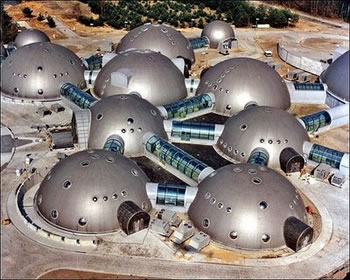Problems to be tackled for lunar stay.
Trivial:
1) Breathing and Water : Recent probes on the moon suspect large deposits of water in the shadowed depths of lunar craters (located near the poles). These deposits can be used to generate both oxygen(along with nitrogen imported from earth) and water for consumption. Denaturing oxygen would need more inert materials like nitrogen. However, our body doesn't use up the nitrogen, and its quantity decreases with an extremely low rate compared to that of oxygen. Hence we needn't worry about nitrogen supply.
2) Energy : There are zones on moon which are 'places of eternal light', i.e. there is an incessant and eternally unobstructed incidence of sunlight. A solar cell placed on such a spot would provide a stable stream of energy.
3) Food : Cultivation can take place indoors in controlled environment, with solar energy being ferried to the particular farm with the help of a set of mirrors to reflect light from eternally sunlit places.

The above problem are those which everyone can imagine to be cohesive, although they are the most convenient to address.
However, there are many issues which make such a moon base concept almost impossible, and are quite unimaginable even for colloquial space enthusiasts.
The real problems facing the moon base:
1) Space radiation (Cosmic rays)
On the earth, the harmful cosmic rays (high energy photons) released from the sun and outer space are blocked by the opaque atmosphere and Earth's magnetic field. It generates a secondary wave of radiation whose intensity is further abased due to the ionosphere, and hence we are protected.
However, space radiation is harmful, and once unprotected, one can have his DNA attacked by the radiation resulting in cancerous cells along with other bodily malfunction. The radiation is one of the major problems facing a plan for a crewed mission on Mars. In case of the Apollo mission the astronauts were on the Moon for relatively short time, i.e. days, and we hence not adversely affected by radiation. But a prolonged stay (months or years) is unthinkable due to the harmful effects of radiation.
2) Solar flares and Solar winds
Powerful surges of energy released by the Sun have harmful radiation which can knock the communication systems down and destroy vegetation and life. With the absence of atmosphere on moon, any life is heavily susceptible to solar activity. We should note that Mars has lost its 'air' due to continuous bombardment of its atmosphere by solar winds.
3) Temperatures
During the lunar day, the surface temperature averages 107 °C, and during the lunar night, it averages −153 °C. It would be impossible to have a stable environment under such temperature constraints.
Addressing these issues...
1) The Lunar soil (Regolith) can be melted and fused to form a glass-like material (Lunar bricks) which can provide protection from harmful radiation, although this would give out secondary radiation which could be even more harmful. The effects of the secondary radiation could be then minimized by employing hydrogen rich plastics. To go to the moon and use the regolith to manufacture Lunar bricks can be a feasible plan to counter deep space radiation.
2) Protection against Solar activity can be achieved by having the hub underground (Possibly under the Lunar dust. The Lunar dust can be an effective shield for protection from solar winds, although communication systems may still be susceptible. Moreover outside exploration during a solar flare could be detrimental.
3) There are some areas on Moon like the 'Peary crater' and 'Malapert Mountain' where the temperature conditions are expected to remain very stable, averaging −50 °C (−58 °F).This is comparable to winter conditions in Earth's the Poles of Cold in Siberia and Antarctica. Establishing a Hub with stable temperature here can be possible.
Of more significance to us is the Peary crater.
The crater is located at the north pole of the moon. A large part of the crater remains in eternal darkness (it never receives sunlight), giving partial protection against solar activity.
The crater has an extremely an low temperature and high depth basin where light elements (volatiles), such as carbon, nitrogen, hydrogen and the most crucial of all, water can exist in pressurized state. Such vital resources can be available close by, just a few kilometers away from the Hub settlement.
The rim of the crater has four mountainous parts which are 'peaks of eternal light'. These unnamed "mountains of eternal light" are possible due to the Moon's extremely small axial tilt, which also gives rise to permanent shadow at the bottoms of many polar craters. Hence having a eternally sunlit area is an ideal location for the much needed perpetual solar energy generator, which can power the base.

The image of the Peary crater floor
The unknown Variable
The most uncertain factor of establishing a Lunar colony is the effect of microgravity on Human physiology. Low microgravity is known to result in a depressed immune system. It can also impair the development of the foetus. The exact details of the adverse physiological malfunction due to microgravity are not known. In short run, microgravity can be handled by wearing a heavy suit (with a large mass), that would balance the reduction in gravity. However, a limitation for this is that it doesn't address the effect of microgravity within the body organs, like less buoyancy for blood, less force exerted by heavy organs on the body parts around them. There have never been any long run experiments to investigate the effects of microgravity on human body and hence it is a subject of uncertainty.

Ignoring the microgravity and solar activity to some extent, we can have a strong candidate for an almost feasible astro-fantasy theme. Cheers!